Updated: 14-Apr-2021
Gnome and Le-Rhone were strong competitors during WWI with their products. Finally Gnome acquired Le-Rhone by 1915. For both, there were other common competitors, such as the newly arrived Hispano Suiza with a superior product.
-The result was not the new Gnome-Le-Rhone, but "Gnome et Rhone", more commonly "Gnome-Rhone" and "G-R" sometimes.
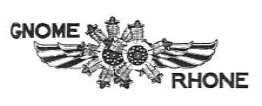
“Logo for the first period”
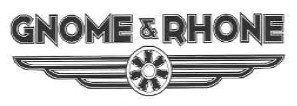
“Next Logo”
-Each of them contributed their products, see the chapters of Gnome and LeRhone. The Gnome production continued with the Type A 7-cylinder that had a power of 80 CV, the type 9B giving 100 CV and the 9N with 160 CV, and in addition, the Double version of each model.
-Le Rhone made the 80 CV 7-cylinder, and the 120 CV 9-cylinder or J9.
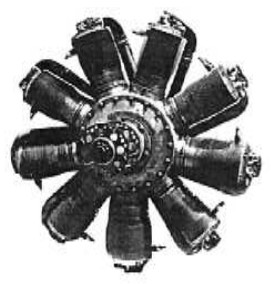
“J 9”
-These engines continued to be manufactured until the end of the war, without abandoning new projects and trials.
-At the end of the conflict and due to difficulties and crises, they were also engaged in the construction of industrial and vehicle engines (and the famous Gnome & Rhone motorcycles).
-In 1920 comes the GR model, the 9-cylinder 9C with a power of 80 CV. The 9R delivered 120 CV and the 9Z gave 60 CV.
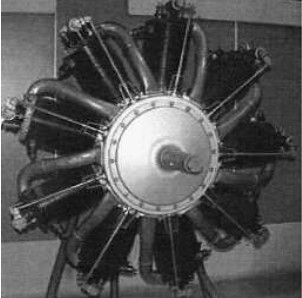
“9C”
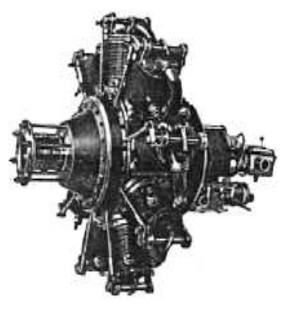
“9Z”
-In 1920 they made the ABC twin-cylinder with 10 hp. It looks like an adapted motorcycle engine. It had a 3 to 1 gearbox, which was a source of breakdowns. It seems that it worked better with direct output. It had a total displacement of 397 cc.

“GR, 10 CV”
-There also was an adapted 22 hp with gear. This time it had superimposed gears, and was destined for light aircraft.
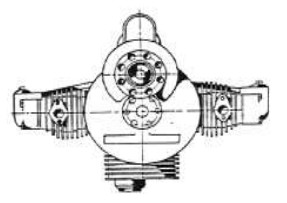
“GR, 22 CV”
-Unlike Hispano Suiza, dedicated to liquid-cooled engines, Gnome-Rhone was evolving the air-cooled radial engines until reaching great powers, as we will see next.
-In 1921 Gnome-Rhone began a production of Jupiter and Titan engines under Bristol license.
-They also acquired the license for the Mercury and the Pegasus, although it seems that these engines did not enter into production.
-It is curious to see that a Gnome-Rhone Jupiter VII, with 450 CV was used in the first Polikarpov I-5 prototype, and a Jupiter VI with 420 CV in the second prototype.

“GR, Jupiter 9Aa”
-The Jupiters were the GR "A" series. They were between 380 CV (like the illustrated 9Aa from 1923) to 525 CV, depending on the variant. They all had 9 cylinders.
-The 9Ab from 1926 gave 420 CV. The 9Ac, 9Ady, and 9Asb delivered 420 CV as well. The 9Ae was more powerful.
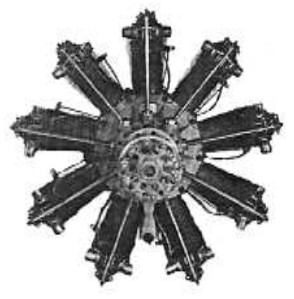
“Gnome-Rhone, Jupiter”
-The 9As, which had compressors, broke at least 3 altitude records, delivering only 380 CV, but maintained it at high altitudes.

“G-R Jupiter in the MAE reserve stock”

“GR, Jupiter 9As”
-The Titan with 5 radial cylinders maintained the same name in Gnome-Rhone which they had in Bristol, just like the Jupiter.
-The Jupiters were modified to rotate RH instead of the English engines which did it LH.
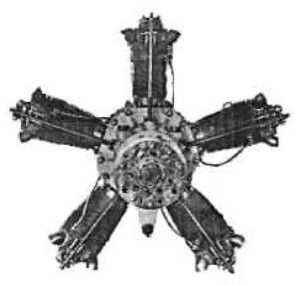
“GR, Titan 5B”
-The designation was "5B" and "5Ba" for the 230 CV engine. (year 1923).
-They continued with the "5Kds" with a power of 250 CV, in 1931.
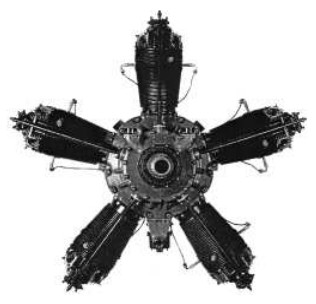
“GR, Titan 5Ba”
-These engines had four valves per cylinder, the mechanism varied from the classic 5K.

“A-series mechanism”
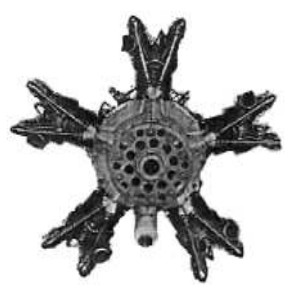
“GR, Titan 5Kds”
-From the 5K they derived the seven-cylinder 7K, or Titan Major. We show two examples of these engines with the front exhaust system.
-The 5K gave 250 CV (1926), and the 7K gave 340 CV (1931).
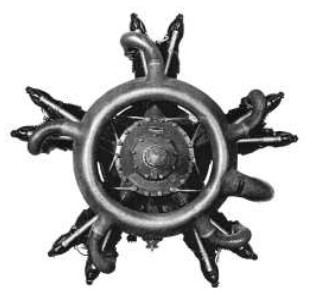
“GR, Titan 5K”
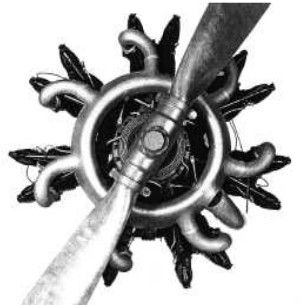
“GR, Titan Major 7K”
-The 7K gave from 340 CV to 430 CV, except the Titan II that delivered only 300 CV. Being an English license with a Left Hand rotation, the French changed it to Right Hand.
-Two more clear 7K engines are shown, including the 7Krf.
-Thereafter came the Mistral, with more displacement and power, from 550 to 600 CV. It had the designation 9K.

“G-R, 7K”

“G-R, 7Krf”

“G-R, 9K Mistral”

“The Mistral at the Safran Museum” (PiP)
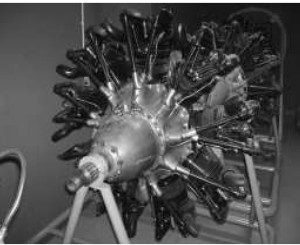
“The Mistral 9Kdr at the MAE”
-Remember that all the illustrations in this publication do not have proportionality or scale, as stated in a previous page.

“A Gnome-Rhone ad in Spanish”
-The 9Krse gave 600 CV, for example. The use of lowercase letters after the series letter, such as Kdrs, Kfs, Kfr, etc. refers to the variants with and without reduction, supercharging, etc. They will not be used in the following series M, N, etc.
-Like the Titan, the Mistral had the Mistral Major. It was the most powerful Mistral version. It had 14 cylinders.
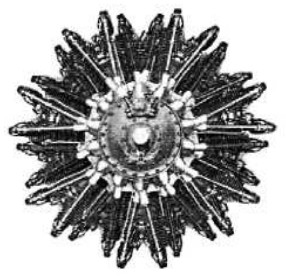
“G-R, 14K”
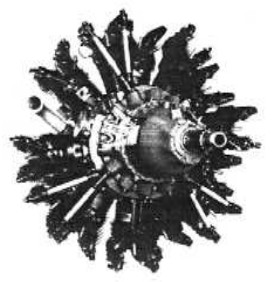
“G-R, Mistral Major 14 Kdrs”
-So, with the same cylinder sizes (146 x 165 mm) we obtain the due greater proportion by having five more cylinders, from 725 to 1000 CV.

“G-R, 14Kfrs, front view”
-We are in the 1930s and the powers for the 14K engines were the ones mentioned above, but we see some variants: the Kds, gave 730 CV, the 14 Kfs gave 900 CV, the 14 Kcs delivered 880 CV, and the 14 Kdrs that is shown gave 860 CV.

“G-R, 14 Kfrs, rear view”
-The majority of the Gnome-Rhone engines have been built under license by various manufacturers in several countries. The 14K is said to have been the base for the Nakajima Sakae on the famous Japanese "Zero" in WWII.
-One of the most successful G-R engines was the Mistral 14 Krsd that gave 800 CV. With this engine altitude records were achieved.
-We can see the difference between a 14 Kfs and a 14 Kfrs, that is, the former without gear and the latter with it.
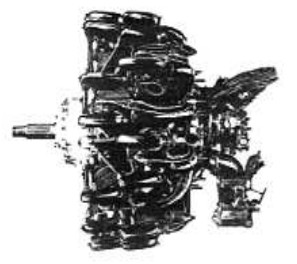
“G-R 14 Kfs”
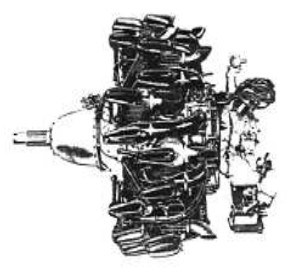
“G-R 14 Kfrs”
-We have known the K series that consisted of the 5K Titan, the 7K Titan Major, the 9K Mistral and the 14K Mistral Major.
-The L-series of 1936, continued to have series letters. It had 18 cylinders and reached 1,400 CV. The 18Lars, is an example.

“G-R 18L”
-The next important series was the 14M, from around 1937.
-These engines were not very powerful. They were smaller than the Ls, as they had 14 cylinders, and the engine measured 0.96 meters in diameter.
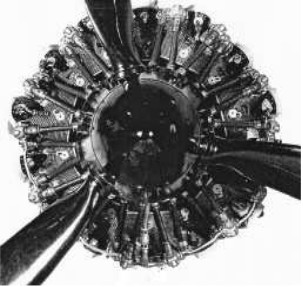
“G-R, 14M” (PiP)
-The 14M engines were known as "Mars". The powers were between 680 and 720 CV. So, the 14M 0/10 gave 710 CV. The 14M-6, -5 or -9, delivered 680 CV or the one shown below that gave 720 CV.
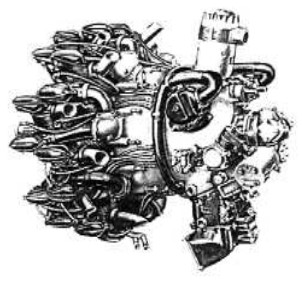
“G-R 14 M, accessory side”
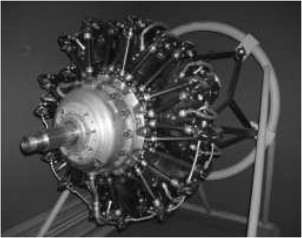
“G-R 14M-35 at the MAE”
-The next series was the 14N with 14 cylinders that appeared around 1936-7.
-After the series letter it had a number (like the Mars) -01, -07, -11, -16, -21, -35, -48, -54, -57 ....
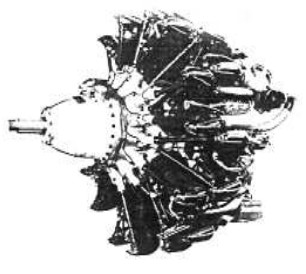
"G-R 14N”
-We see the side-view drawing of the 14N-07 from the PZL P.24 aircraft. It is a 950 CV engine from Gnome-Rhone. We can see the front gearbox very clearly.

“Side-view drawing of the 14N”
-The powers of the N series were between 920 and 1,120 CV, the latter is the below engine that gave its power at 2,400 rpm with 38.7 liters of displacement.
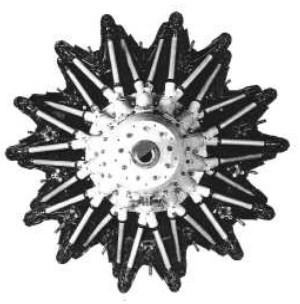
“G-R, 14 N at the MAE museum”
-Other Gnome-Rhone 14N-type engines are forming part of the reserve stock at the Air and Space Museum (MAE) in Le Bourget, Paris.
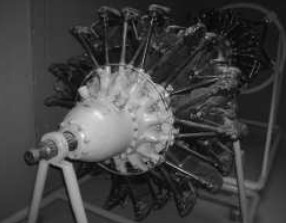
“14N-25 at the MAE”
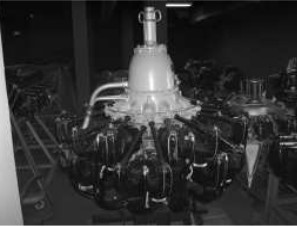
“14N-48, at the MAE”
-The 14P from 1938 that delivered 1,200 CV was supercharged and derived from the 14N. This engine remained as a prototype.
-It also was a 14-cylinder radial engine with two rows of cylinders.
-There also was an 18P, which should have given 1,650 CV. This engine neither went into production.
-The 18R series with a large gearbox giving 2,150 CV, had 18 cylinders again and was from 1939/40.
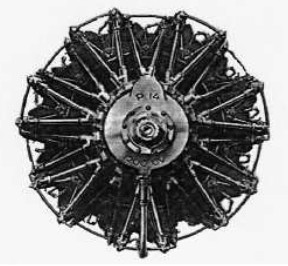
“G-R 14P”
-The 18R gave 2,150 CV at 2,500 rpm, with a 2-speed compressor. The 18R reached 2,400 CV at 2,600 rpm in 1946.

“G-R, 18R, 2150 CV”
-There was a 14R version from 1940 with 14 cylinders in two coupled rows. The one shown below gave 1,320 CV at 2,400 rpm and had 38.7 liters of total displacement. The engine weighed 820 Kgs.
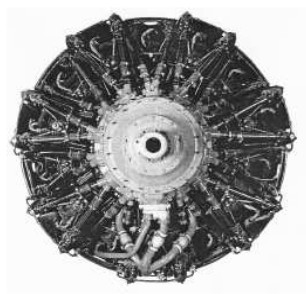
“G-R, 14R”
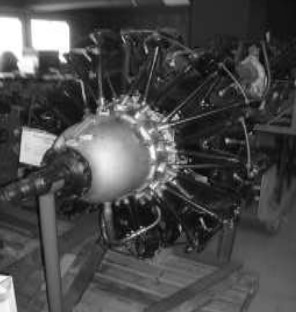
“14R in the MAE reserve stock”
-Working with big gearboxes, the 18U engine's still seems larger than the 18R. An engine from 1949, when Gnome-Rhone was already absorbed by Snecma (see). It had 44 liters of total displacement and delivered 2,200 CV of power.

“G-R 18-cylinder cutaway at the MAE”
-This 18-cylinder allows us to see the interiors of the epicyclic gearbox. The engine is still in its transport support.
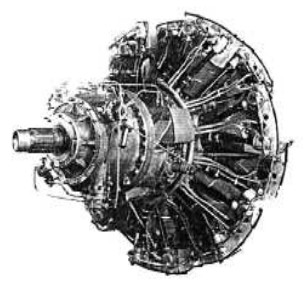
“G-R, 18U”
-During the invasion of France and consequent occupation of the Gnome-Rhone factories, the Germans made use of the G-R engines and mounted them on some of their own aircraft.
-For example, on the Me-323 D-1 "Giant" (a motorized version of the great Me-321 glider) they mounted six Gnome-Rhone 14N engines. It had three-blade propellers.
-NOTE: On the Me-323 D-2, the engines were LeO with two-blade propellers.
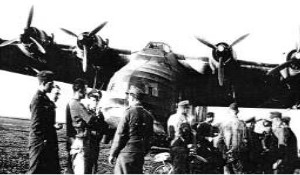
“Me 323 D-1, with Gnome-Rhone engines”
-During that time they continued to develop engines such as the 18T, a little known 28-cylinder prototype from 1944 with 4 rows of 7 cylinders. It had a front fan to force the cooling air in a BMW-801 style. The second and fourth rows were aligned and displaced with respect to the first and third, which were aligned with each other as well. It was in fact a development from the 14K and 18R.
-The power was set to 3,700 CV at approximately 6,000 meters of altitude.
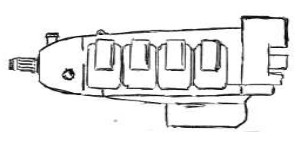
“X-8 project”
-Towards 1941, there was a project of a horizontally-opposed 8-cylinder engine. It should give 600 CV, but it did not prosper.
-Little known were GR's Pegasus and Mercury.
-Neither well known was the diesel engine made under Packard license, and manufactured during the 1930's.
-At the end of 1944, Lorraine was absorbed by Gnome-Rhone, and at the end of the war in 1945, the French engine companies were nationalized and integrated into the SNECMA group (Societé National d'Etudes et Construction de Moteurs d'Aviation) .
From Appendix 6: In the beginnings of this company, engines were made under license, which is the case of Bristol's Jupiter, Mercury.
-The Mercure was the Bristol Mercury made in France by Gnome-LeRhone.

“Gnome-Rhone Mercure”
From Appendix 9: During the Second World War, under the German occupation GR manufactured the BMW 132.
-As from 1921, Gnome-Rhone acquired the licenses for the Titan and the Jupiter from Bristol in the UK.
-The Jupiter was modified to rotate in the opposite direction to that of the English originals.

“Jupiter engine exposed at the Villaroche Museum”
-The above photo is the one of a Jupiter that was exhibited at the Snecma (now Safran) museum in Villaroche between 1985 and 1991. It is noteworthy that this engine had a cut-out section at the front crankcase for the cam plate, which was the key-part to get the engine to rotate in the opposite direction.
-The engine was manufactured between 1922 and 1929. Bristol authorized licensing and marketing to all countries that were not Commonwealth, in turn Bristol was representative of the French Jupiter in their area.
-Through the French Gnome-Rhone there were other sub-licenses to manufacture the Jupiter in at least fourteen countries:
-German Siemens-Halske built it, and this is precisely the engine that was used on a variant of the great Dornier Do-X seaplane.
-In Switzerland, Adolf Saurer's metallurgical company built it.
-In Yugoslavia and Hungary? IAM (Industria Aeroplaskih Motora) made it in collaboration with Manfred Weiss's company.
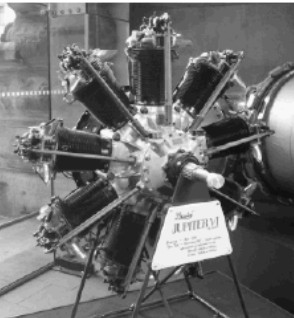
"Perhaps the most constructed was the Jupiter VI" (AEHS)
-In Russia it was built as the M-22.
-In Italy, Piaggio and Alfa Romeo, as RC35-126.
-In Portugal, OGMA built it as the P-50 model.
-In the USA it was manufactured by Bliss.
-In Japan this engine was made by Kawasaki? and Nakajima.
-In Rumania at the IAR factory.
-In Belgium by SABCA.
-It is possible that in Sweden also some engines were made, but information is missing.
-For all of them, the license was granted by Gnome-Rhone as these countries were not in the Commonwealth.
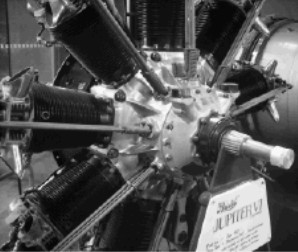
“Closer photo of the engine” (AEHS)
-Bristol's most outstanding feature, and that of the Jupiter, of course, is the cylinder valve drive: the French called it "Expansion Compensation".

“Expansion compensation device details”
-It is that the rocker arms are on shafts that are pivoting on the cylinder head and are fastened by a strap to the central crankcase. It is the rod that we see in the center of the two control rods. It's great.
-The cylinders that are attached to the central block by the base, "elongate" with temperature.
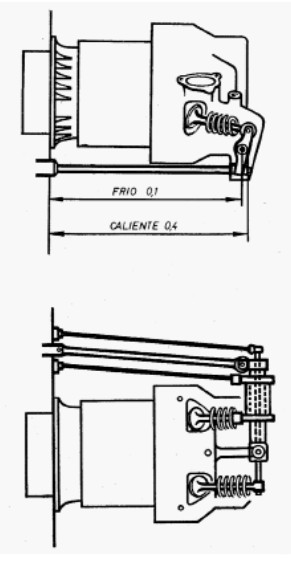
"From a book by the same author, RMV"
-Other originality of this radial engine was the use of four valves per cylinder, two intake and two exhaust ones.
-Concretely the above drawing shows the control for two of the four valves mentioned in the previous paragraph.
-There are several types of rocker combinations on the Jupiters.
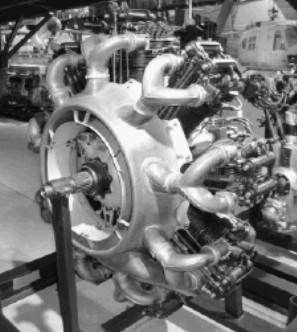
“Double compensation shaft” (AEHS)
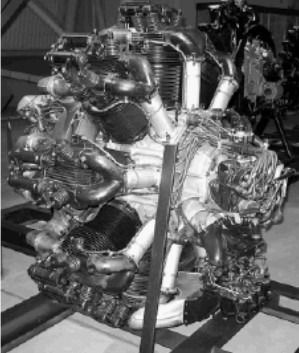
“The Jupiter VIIIF, with three carburetors and supercharger” (AEHS)
-Another detail of the Gnome-Rhone Jupiter was its reverse rotation to Bristol's original engines.
-At the current Safran Museum in Villaroche, there is a Titan that rotates LH and a Jupiter that does it RH.
-It is a modification carried out by G-R, and we assume that this is obtained mainly through the cam plate.
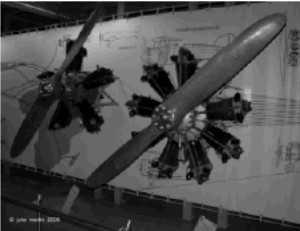
“The above mentioned engines” (AEHS)
Engines of GNOME - RHONE
Model: 14K, -Kdrs, -Kfrs, -Kds, -Kfs, -Kcs, -Krsd.. Mistral Major
Arquitecture: 14-cylinder Radial
Cooling: Air
Total Displacement:
Bore / Stroke:
Power: CV
Weight:
Powers from 725 to 1,000 CV.

"Gnome & Rhone, Mistral Major 14Kdrs"
Model: 14M, -5, -6, -9, -25.. Mars
Arquitecture: 14-cylinder Radial
Cooling: Air
Total Displacement:
Bore / Stroke:
Power:
Weight:
Powers between 680 and 720 CV.

"Gnome & Rhone, 14M-35 at the MAE"
Model: 14N, -01, -07, -11, -16, -21, -25, -35, -48, -54, -57..
Arquitecture: 14-cylinder Radial
Cooling: Air
Total Displacement:
Bore / Stroke:
Power:
Weight:
With powers between 920 and 1120 CV.

"Gnome & Rhone, 14N-25 at the MAE"
Model: 14P
Arquitecture: 14-cylinder Radial
Cooling: Air
Total Displacement:
Bore / Stroke:
Power: 1200 CV
Weight:
Only prototype.

"Gnome & Rhone, 14P"
Model: 14R (Météore)
Arquitecture: 14-cylinder Radial
Cooling: Air
Total Displacement: 38700 cc
Bore / Stroke:
Power: 1320 CV @ 2400 rpm
Weight: 820 Kg

"Gnome & Rhone, 14R at the MAE reserve stock"
Model: 18L, -Lars
Arquitecture: 18-cylinder Radial
Cooling: Air
Total Displacement:
Bore / Stroke:
Power: 1400 CV
Weight:

"Gnome & Rhone, 18L"
Model: 18P
Arquitecture: 18-cylinder Radial
Cooling: Air
Total Displacement:
Bore / Stroke:
Power: 1650 CV
Weight:
Only prototype.
Model: 18R
Arquitecture: 18-cylinder Radial
Cooling: Air
Total Displacement:
Bore / Stroke:
Power: 2150 CV @ 2500 rpm
Weight:
With 2-speed compressor.

"Gnome & Rhone, 18R, 2150 CV"
Model: 18T
Arquitecture: 28-cylinder Radial
Cooling: Air
Total Displacement:
Bore / Stroke:
Power: 3700 CV
Weight:
Only prototype.
Model: 18U
Arquitecture: 18-cylinder Radial
Cooling: Air
Total Displacement: 44 Ltr.
Bore / Stroke:
Power: 2200 CV
Weight:

"Gnome & Rhone, 18U"
Model: 2, twin-flat, 22 CV
Arquitecture: Horizontally opposed
Cooling:
Total Displacement:
Bore / Stroke:
Power: 22 CV
Weight:
Model: 5B, -Ba, Titan (Lic.)
Arquitecture: 5-cylinder Radial
Cooling: Air
Total Displacement:
Bore / Stroke:
Power: 230 CV
Weight:

"Gnome & Rhone, Titan 5B"
Model: 5K, -Kds, Titan (Lic.)
Arquitecture: 5-cylinder Radial
Cooling: Air
Total Displacement:
Bore / Stroke:
Power: 250 CV
Weight:

"Gnome & Rhone, Titan 5K"
Model: 7K, -Krf, Titan Major
Arquitecture: 7-cylinder Radial
Cooling: Air
Total Displacement:
Bore / Stroke:
Power:
Weight:
With powers between 340 CV and 430 CV.

"Gnome & Rhone, Titan Major 7Krf"
Model: 9
Arquitecture:
Cooling:
Total Displacement:
Bore / Stroke: x
Power:
Weight:
Model: 9A, -Aa, -Ab, -Ac, -Acy, -Asb, -Ae, -As...Jupiter Lic.)
Arquitecture: 9-cylinder Radial
Cooling: Air
Total Displacement:
Bore / Stroke:
Power:
Weight:
With powers between 380 CV and 525 CV.

"Gnome-Rhone, Jupiter"
Model: 9C
Arquitecture: 9-cylinder Radial
Cooling: Air
Total Displacement:
Bore / Stroke:
Power: 80 CV
Weight:
Model: 9J (J9)
Arquitecture:
Cooling:
Total Displacement:
Bore / Stroke: x
Power:
Weight:

"Gnome & Rhone, J9"
Model: 9K, -Kdr, -Krse, -Kfs, -Kfr, -Kdrs, Mistral
Arquitecture: 9-cylinder Radial
Cooling: Air
Total Displacement:
Bore / Stroke:
Power:
Weight:
Powers from 550 to 600 CV.

"Gnome & Rhone, The Mistral 9Kdr, at the MAE"
Model: 9Z
Arquitecture: 9-cylinder Radial
Cooling:
Total Displacement:
Bore / Stroke:
Power: 60 CV
Weight:

"Gnome & Rhone, 9Z"
Model: BMW-132 (WWII)
Arquitecture:
Cooling:
Total Displacement:
Bore / Stroke: x
Power:
Weight:
Model: Mercure (Mercury Lic.)
Arquitecture:
Cooling:
Total Displacement:
Bore / Stroke: x
Power:
Weight:

"Gnome & Rhone, Mercure"
Model: X-8
Arquitecture: 8-cylinder Horizontally opposed
Cooling:
Total Displacement:
Bore / Stroke:
Power: 600 CV
Weight:


